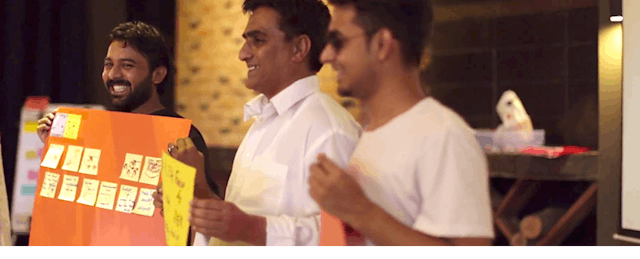We’re in the age of the sharing economy. A few years ago, hopping into the backseat of a stranger’s car or sleeping in their guest room might have been a scary prospect. Today, companies like Airbnb and Uber have made sharing with strangers seem totally normal. Yet, online courses haven’t quite figured out how to cultivate this same type of sharing culture. Large MOOC providers focus on offerings that promise individual career advancement and skills development rather than social learning. While we have more data than ever about where and when people are learning, we still haven’t cracked the code on how to use technology to foster trusting learning communities.
+Acumen has been building courses for teams since 2013, and, while we still don’t have all the answers, we know that people remain hungry for real, in-person connection. Adults have always enjoyed learning together—whether in book clubs, literary salons or meetup groups like the famous Homebrew Computer Club. Coursera and the US Department of State have done important work to create a network of learning hubs, “physical locations scattered across the globe where MOOC students can meet in person to collaborate,” and we think this is a good first step. However, trying to retrofit MOOCs designed for individual learning to facilitate collaboration is tougher than it might seem. As any good teacher will tell you, activities for groups have to be designed differently than assignments for individuals. If you try to give a group of fourth graders a single worksheet to complete, not much meaningful learning will occur. We think the same principle applies to online course design. Here are seven tips we’d give to instructional designers looking to build community around online courses:
1. Think of online courses as a way to facilitate offline learning. Not all learning has to be confined to videos and multiple choice quizzes. Envision the online platform as a scaffold for offline work. For example, DIY.org gives kids instructions for activities they can complete offline like baking bread or building a bike light. Then they upload evidence to the platform to receive a digital badge. +Acumen courses similarly ask participants to get outside and interview customers, hold a discussion group or build a prototype and then share what they learned back on the platform.
2. Build playbooks and kits. Somewhat counterintuitively, people taking online courses still like something they can print & bring to a group meeting. Many of our courses feature “playbooks” that can be downloaded as a PDFs. People also like to assemble learning “kits” to accompany online courses. Just as Blue Apron packages all the ingredients needed for a meal, instructional designers can prepare a list of all the supplies people need for course activities. For example, here’s one IDEO.org created for our upcoming Prototyping course:

3. Use a “Choose Your Own Adventure” approach to course design. Adults want to feel in control of their time and learning. Most of our courses have the option to complete assignments using a pre-designed case study. Teams can also work on a personal project, an option which about 40 percent of teams select. Having this “choose your own adventure” format makes all group members feel more motivated to complete the work.
4. Look for platforms that enable team formation, team work spaces and assignment galleries. We’ve experimented with building courses on NovoEd, EdCast and Wordpress. NovoEd uniquely enables people to use a team workspace and view submissions from other groups in an assignment gallery. At the same time, we encourage people to share their work on Twitter and use Google Hangouts or appear.in to hold virtual meetings. Don’t feel like you have to confine a course to one learning management system or platform.
5. Leverage “course catalysts” to facilitate connections between teams. Our team relies on volunteers to facilitate discussion forums, an idea we first saw piloted in Leticia Britos Cavagnaro’s Design Thinking Action Lab course from Stanford. A course catalyst can point out overlapping interests to the teams and encourage them to share ideas with others from around the world.
6. Make instructions very explicit to reduce logistical hassles. We designed a ‘course overview’ deck that presents best practices for forming teams.We added resources to assist with group facilitation, including tips for moderating discussions and polling cards to get everyone quickly on the same page. Having these clear and detailed guidelines ensures that a group clicks quickly, rather than spending a lot of time spinning their wheels.

7. Enable people to learn new things about the people around them. In our MOOC on storytelling, individuals completed life maps tracing their personal histories & then shared them with the group. Having this structured way to learn new things about each other propelled a sense of connection. Adults don’t necessarily want gamification, but they like activities that offer surprising insights and feel practical or fun.
After two years of running team-based courses for thousands of learners globally, we’re heartened by the ingenuity, resourcefulness and dedication of learners that come together around online courses and defy low completion rates. In fact, an inverse MOOC model that enables learners to co-create ideas, rather than simply being recipients of transmitted information might be one of the most exciting and overlooked developments happening in education right now. The MOOCs of 2012 were limited to lecture videos and multiple choice quizzes, but the MOOCs of 2015 are pushing the format forward in new directions. They’re worth a second look. Just as we’re using technology to share things like cars, houses or meals in new ways, we need learning environments where people feel empowered to get out from behind their screens and build offline communities that can then be amplified and analyzed online.


